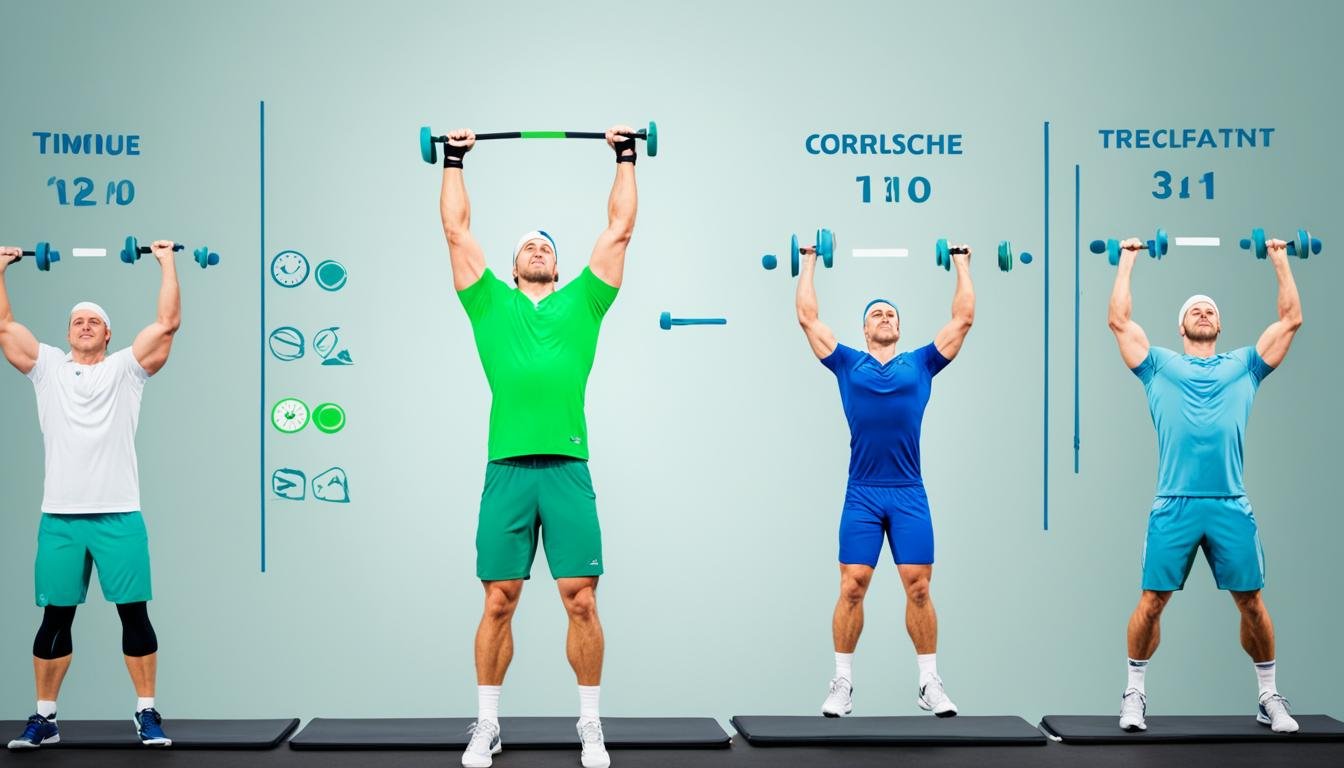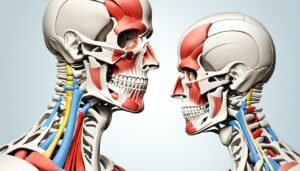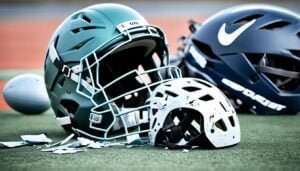Concussion happens when you hit your head or move it too fast. About 1.4–3.8 million Americans get concussions each year.1 Doctors need to know about concussion’s effects on a person’s ability to move. The injury has the most impact on the brain within the first three days. But, even after 15 days, the brain is still trying to heal.
Fast diagnosis of a concussion and the right treatment are very important. This helps the person recover well and avoids serious problems like a second injury making things worse.
Returns to sports or activities must follow certain rules to keep safe. The main aim is to prevent bad effects from future brain injuries.
Key Takeaways
- Concussion is a common mild traumatic brain injury, with 1.4-3.8 million cases occurring annually in the United States.
- Prompt diagnosis and proper treatment are crucial to promote healing and prevent further complications.
- Consensus guidelines outline a structured return to play protocol for athletes recovering from a concussion.
- Monitoring symptoms and gradually increasing activity levels are essential for a safe and successful return to normal activities.
- Seeking medical guidance and utilizing rehabilitation services can support a full recovery and prevent future concussions.
Understanding Concussion
Definition and Causes
A concussion is a mild type of traumatic brain injury. It happens when the head faces a hard hit. This can come from a blow or a quick stop or start. In 2012, experts meeting about sports injuries said a concussion is a brain injury. It comes from the brain being shaken or hit hard after a forceful event. This causes the brain to not work right for a bit.2
Even though there are no big signs in the brain, it doesn’t function normally. This happens due to a series of processes in the brain. These occur right after the hit. These processes change the chemical and energy use in the brain.
Signs and Symptoms
Spotting a concussion early is super important. Most times, you won’t pass out. This makes it hard to know if you have one. Signs can include headaches and feeling dizzy. You might not know where you are for a bit. Nausea and throwing up can happen, too. Other signs may be obvious to someone looking at you. You might look distant, speak slowly, or have a hard time focusing.2
Bad coordination or slurred speech are also signs. You might feel very anxious or tired. People with a concussion often can’t remember well. They might get upset easily or feel on edge all the time. Headaches are the top complaint.
Concussion Statistics
The CDC says there are between 1.4 to 3.8 million concussions each year in the U.S.2 But, it’s hard to know the exact number. This is because the term ‘concussion’ isn’t always used clearly. Also, many cases might not be reported.
Immediate Care After Concussion
The main focus after a concussion is both physical and mental rest.3 This means avoiding schoolwork, video games, and screen time. When symptoms disappear, a step-by-step return to sports can begin.4
Physical and Cognitive Rest
Doctors advise complete rest for the first days after a concussion to help the brain heal.4 Gradually, one can start doing more each day but should stop if symptoms return or get worse.4 Simple exercises like biking can be beneficial for recovery.4
Monitoring Symptoms
If a player might have a concussion, they should be taken out of the game right away.5 It’s crucial to watch for any symptom changes. If symptoms worsen or new ones pop up, getting urgent medical help is important.5 Signs of a severe injury can show up in the first day or two.5
For most with concussions, symptoms get better within weeks.5 It’s best to rest in the first 24 hours. Common symptoms include feeling tired, trouble sleeping, and dizziness.5 People usually start feeling improved within two weeks, but it can last longer for some.5
Take any prescribed medicines, and always talk to your doctor about them.5 If symptoms don’t improve or new ones show up, seek medical advice.5
when can you return to normal activity after a concussion
Most concussions get better within 7 to 10 days.2 Kids and teens might take longer to recover.2 But, even when symptoms seem gone, the changes in the brain are not always fixed.2 Some people still have symptoms after 3 months, which happens to about 15% of patients.2 To return to regular activity, you should take it slow and only with your doctor’s okay.6
| Concussion Recovery Timeline | Percentage of Patients |
|---|---|
| Short (7-10 days) | 80-90% |
| Persistent Symptoms (>3 months) | 15% |
After resting for 1 to 3 days, athletes can start getting back to their usual routine.6 They should gradually increase their physical activities, making sure it doesn’t make their symptoms worse.6 Their thinking skills are also closely checked by experts.6 Doctors keep a close eye on them every two weeks, looking for signs they’re getting better emotionally and with sleep.6
Sadly, very severe brain injuries from youth sports are possible, though very rare.2 In many places, coaches must learn about recognizing concussions every year. This rule applies to kids 11 to 18, thanks to the youth sports concussion law (Senate Bill 40).2 For a player who’s had several concussions, it’s very important to consider factors like the number and timing of the injuries before they go back to playing.2
Deciding if an athlete should retire due to concussions is a careful, case-by-case process.2 No single test can tell if someone’s ready to play again.2 Some sports programs do baseline cognitive tests to help understand when it’s safe to return after a concussion.2
Experiencing a second concussion before fully recovering from the first can lead to a very severe condition called second impact syndrome.6 Rejoining sports too soon might delay healing or cause this dangerous syndrome.6 Working to strengthen neck muscles may lower the chances of future concussions.6
Graduated Return to School
After a concussion, children need a step-by-step plan to return to school and normal activities. This concussion comeback plan for students makes sure they safely go back to school.
Step 1: Daily Activities at Home
For the first day or two, they should rest gently but keep up daily tasks. Also, they should start walking to get back to light exercise.7 Enough sleep, good food, and less screen time are key.
Step 2: School Activities at Home
Next, they can add light educational tasks at home. This includes homework or reading for school. It helps them get used to doing schoolwork again.7
Step 3: Return to School Part-time
They might begin with a shorter school day. Or they can take more breaks. It’s important to talk to the school about finding quiet spaces for breaks. They may also need to adjust when they take tests.7
Step 4: Return to School Full-time
As they get better, they can do more at school. They should not rush but slowly get back to full days. This way, they can join all school activities and catch up on what they missed.7

Graduated Return to Sports
Athletes recovering from a concussion should not play sports. This includes practices and workouts.6 The approach to coming back, called graduated return to play (RTP), involves steps done over time. Each step takes a minimum of 24 hours.
Step 1: Symptom-limited Activity
The first step involves very light activities that don’t increase symptoms, like walking.6
Step 2A: Light Aerobic Exercise
In the next step, athletes can start with gentle walking, swimming, or slow biking. This exercise should be without any added resistance.6
Step 2B: Moderate Aerobic Exercise
After that, they can increase the pace a bit with their walking, swimming, or biking. Still, no tough resistance work is allowed.6
Step 3: Sport-specific Exercise
Now athletes can add some running, basic warm-ups, and ball skills with a soft ball. But they must avoid any drills with head impact.6
Step 4: Non-contact Training Drills
It’s time for more serious training, like advanced passing. They can slowly get into more intense training.6
Step 5: Full Contact Practice
After being cleared by a doctor, they can join full-contact training. This phase helps get them back to regular play while their skills are checked by the coaching staff.6
Step 6: Return to Sport
Returning to Normal Activities
Work and Daily Routines
After a concussion, athletes can slowly do more work and daily tasks. This is fine as long as it doesn’t make their symptoms worse.8 Doctors will say how much they can do and when they can go back to their normal life.
Physical Activities
They can start with easy physical activities like walking or cycling. Reading or watching movies is okay too.6 They should stop if their symptoms get a little worse but only for a short time.
| Return to Normal Activity Progression | Timeline |
|---|---|
| Complete rest | 1-3 days6 |
| Light aerobic exercise (walking, swimming) | Gradually increase as tolerated6 |
| Moderate aerobic exercise (jogging, cycling) | Gradually increase as tolerated6 |
| Sport-specific activities (running drills, ball handling) | When symptom-free with exertion6 |
| Full return to normal activities | After medical clearance6 |
Risk of Multiple Concussions
If an athlete has several concussions, their doctor might say to stop contact sports. They should avoid activities that could lead to more head injuries. This pause is needed because a hit to the head can slow down a person’s reactions and thinking. This makes them more likely to get hurt again.9 A person who’s had one concussion faces a higher risk of getting another within the first year.9 And, with each concussion, their chances of having long-term issues increase. These problems can include symptoms that last a long time, known as post-concussion syndrome.9
Post-Concussion Syndrome
Post-concussion syndrome means having at least three concussion symptoms for three months or more.9 Around 15% of people who get concussions develop this syndrome.9 if concussions happen a lot, they can affect the whole body.9 For example, they can mess up the way the body’s nervous systems work together. This can lead to both thinking and physical problems.9 Also, hormone issues can stick around after a concussion. This can affect the way hormones that control growth, stress, and other body functions work.9
When to Seek Medical Attention
If a concussion is suspected, getting medical help fast is key. Signs to watch out for include acting strangely, a strong and ongoing headache, throwing up often, and any bleeding from the ear or nose. Seizures, trouble waking up, or if things get worse or new symptoms show up also mean you need to see a doctor fast.10 Immediate care helps manage the situation, lowering the risk of more serious problems.
With concussions, symptoms might suddenly get worse. It’s crucial to keep an eye on the person. How they recover depends on their general health, past concussions, the injury’s seriousness, and if they drink or use drugs.11 Not paying attention to worsening symptoms or going back to regular activities too soon can cause lasting damage. This includes brain issues, constant headaches, and in rare cases, death.11
Doctors use specific exams to check concussion symptoms and how someone is getting better. It’s important to follow the advice of healthcare professionals. This might involve seeing a doctor like Dr. James Messerly. He’s an expert in concussions, orthopedics, and sports medicine. Doing what they say can lead to a speedy and safe recovery.11
Concussion Recovery Timeline
About 80 to 90 percent of concussions clear up within 7 to 10 days. But, kids and teens might take longer to get better.12
The changes inside the brain may not be fully fixed when symptoms go away. This is especially true in younger patients.12
For some, symptoms last more than 3 months. This happens to around 15 percent of people with a concussion.12
Rehabilitation and Support Services
If a child still has symptoms after a concussion, they may need care at a rehab service. The RCH Victorian Paediatric Rehabilitation Service (VPRS) is one place that can help.13 They offer different therapies and tests. These are to make sure the child gets back to normal.13 There are also groups that can offer support to those recovering from a TBI. Staying connected can be very helpful during this time.13
Rest is very important for concussion recovery, for the body and brain to heal. Balance therapy helps with coordination and prevents falls.14 Exercises like aerobics, strength training, and coordination activities are good too. They can lessen symptoms and improve both physical and mental abilities.14 A proper diet full of nutrients and vitamins is also key for getting better after a concussion.14
Kids feel the effects of concussions more than adults due to their brains still growing.14 If a young athlete gets a concussion, they might take longer to recover than older athletes.14 Symptoms can range from headaches and confusion to nausea and mood changes.14 Even after these symptoms go away, there might still be lasting issues with memory and thinking.14
A lot has been learned about mild traumatic brain injury. Studies have detailed the risks and ways to prevent it.15 Being in the military might raise the risk of these injuries, especially in places like Iraq and Afghanistan. People in the military have access to health services to help with these injuries.15
Using rehab services and support can really help children and others bounce back from concussions. It increases the chance of a full recovery.1314
Preventing Future Concussions
Despite our best efforts, concussions still happen. Yet, being proactive can help lower the chances of getting a head injury. It’s vital that athletes use the right protective gear, like helmets, for risky sports.6
Protective Gear
A helmet is a must for activities where you might fall and hit your head, such as biking. While it’s not a complete shield, helmets do lower the risk of head injuries.6 Coaches and parents need to be sure that the athletes have and wear the right safety gear.
Technique and Safety Measures
Along with gear, coaches must focus on proper playing techniques and safety steps.2 They should teach how to safely tackle, block, and do other physical moves. This education helps athletes enjoy sports while being safer from concussions.2
Creating a full-detailed concussion prevention strategy is key. This includes using protective gear, teaching safe moves, and sticking to safety rules.62
Conclusion
Getting back to normal after a concussion needs a planned approach. It’s key to follow the steps for going back to school and sports safely. This helps in making sure you get better and avoid more harm.1
Every year, between 1.4 and 3.8 million people get concussions in the U.S. Most of these, about 80 to 90%, heal within a week or two. But, kids and teens might take longer to recover. Sadly, about 15% face problems that last more than three months.1
To return to playing, athletes should listen to their doctor and use rehab. There are ways to prevent future concussions too. Most of the time, symptoms go away in about two to three weeks. But this can drag on if the injury isn’t treated right.3
A full plan for concussions is necessary. It starts with education and tests before the concussion. Then, it involves keeping check on the injury and slowly getting back into action.3
Following the right steps and getting help from professionals, athletes can safely join back in. A lot is known about how to deal with and stop these brain injuries. With good care, you can beat a concussion and get back to your usual life and sports without much risk.15
FAQ
When can you return to normal activity after a concussion?
What is the concussion recovery timeline?
When can you return to work after a concussion?
When can you resume exercise after a concussion?
What are the post-concussion activity restrictions?
What are the concussion rehabilitation guidelines?
How can you safely return to activities after a head injury?
How do you manage concussion symptoms during recovery?
Source Links
- https://www.ncbi.nlm.nih.gov/pmc/articles/PMC6143567/
- https://www.childrenscolorado.org/conditions-and-advice/sports-articles/sports-injuries/concussion/play-after-concussion/
- https://my.clevelandclinic.org/health/diseases/15038-concussion
- https://www.mayoclinic.org/diseases-conditions/concussion/diagnosis-treatment/drc-20355600
- https://myhealth.alberta.ca/Health/pages/conditions.aspx?Hwid=custom.ab_concussion_ac_adult
- https://www.hackensackmeridianhealth.org/en/healthu/2021/10/18/when-is-it-safe-to-return-to-sports-after-a-concussion
- https://www.ncbi.nlm.nih.gov/pmc/articles/PMC10266389/
- https://www.cognitivefxusa.com/blog/exercise-after-a-concussion
- https://www.cognitivefxusa.com/blog/multiple-concussions-effects-and-treatment
- https://www.lifespan.org/lifespan-living/concussion-recovery-and-how-safely-return-normal-activity
- https://bonejoint.net/blog/when-is-it-safe-to-return-to-activities-after-a-concussion/
- https://www.beaumont.org/conditions/what-to-expect
- https://www.cdc.gov/traumatic-brain-injury/response/index.html
- https://www.fyzical.com/springhill/blog/How-Physical-Therapy-Can-Assist-in-Concussion-Recovery
- https://www.ncbi.nlm.nih.gov/pmc/articles/PMC7703689/




